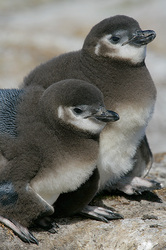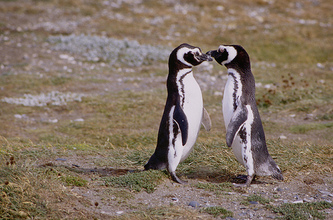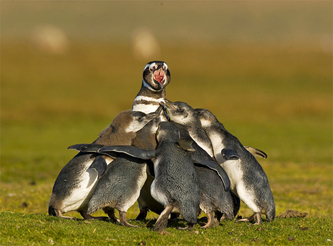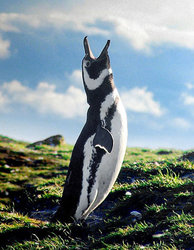April Penguin
No one really chose April's Monthly Penguin. But someone else can choose May's Monthly Penguin! E-mail [email protected] or [email protected] with your penguin, some information about it, and pictures of your penguin. Be sure to check back to see if your peguin got chosen!
April: Magellanic Penguin
Magellanic penguins inhabit the cold temperate waters and subantarctic regions of coastal Chile and Argentina. Significant breeding populations are located on Juan Fernandez Islands, Staten Island, Tierra del Fuego, and the Falklands. Magellanics are often found in association with Humboldt penguins and although they do not interbreed, distinguishing between the two is sometimes difficult. Magellanic penguin populations are considered to be stable, however, they do face threats from oil spills, overfishing of their food supply, and fishing net entanglement.Like its three other closely related relatives in the Spheniscus genus, the Magellanic penguin has black-to-brown shading on its back and white coloring on its breast and trunk. Their chests have scattered black spots. The Magellanic can be distinguished from Humboldt and African penguins by the two bands crossing its front. One band is a wide black strip under the chin and another is in the shape of an upside down horseshoe on the stomach. In Humboldts, this band is somewhat incomplete and in Africans it is absent. Magellanic Penguins have very dense feathers: more than 70 per square inch. The feathers have oil on them, for waterproofing. Their 'tuxedo' attire not only gives them a somewhat comical air, but it also helps hide them from predators. The white belly blends in with the bright sun on land, while the black back blends in with the dark ocean waves.Magellanic penguins are excellent long distance swimmers, and often hunt in groups to aid in catching prey. Using their wings like paddles they can achieve speeds of over 15 miles per hour. Their diet consists of krill, fish, squid, and other small seafoods caught on relatively shallow pursuit dives.Breeding season for the Magellanic penguins is from late September to early February when adults come to shore to establish nesting sites within loose colonies. Naturally shy and seclusive on land, mated pairs nest in deep burrows (often hiding there when disturbed) where the female lays two eggs. Both the male and female share in the responsibility of caring for the chicks, often taking shifts lasting ten to fifteen days while the other hunts for food. The eggs take five to six weeks to hatch and the chicks will stay in the burrow for another month when they will molt into their adult feathers. At 60 to 70 days old the chicks are ready to head out to sea.Magellanic penguins are occasionally preyed upon by the Southern sea lion. Unguarded or abandoned chicks and eggs fall prey to the Kelp Gull and the Giant Petrel.






